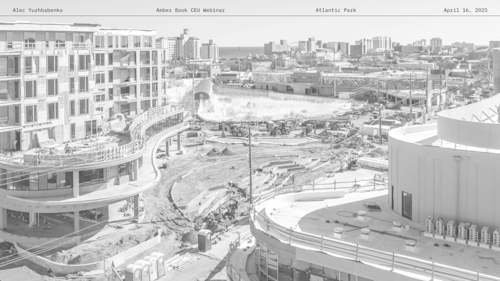
If you’re looking to practice architecture in a place known for sunshine, oranges and theme parks, then there’s only one place for you — well, maybe two places, but we’re not talking about Florida today. This article is for those of you hoping to practice in the Golden State and carry on the legacy of Irving Gill.
California is one of the states with the most complex regulations for getting licensed as an architect, and it is one of only a couple of states to require an additional exam beyond NCARB’s ARE. Below, we will discuss how licensure in California works, but first, we’ll take a look at what and who dictates and administers the process.
The process of architectural registration in California is overseen by the California Architects Board (the Board). The Board provides detailed and comprehensive information about all aspects of the initial licensure process under the Candidates section of its website. Within that section, the Board maintains the Architects Practice Act, which collects and links to the relevant statutes of California's Business and Professions Code and the California Code of Regulations. Together, those two primary sources comprise the legal basis for California’s architectural licensure process.
I generally encourage licensure candidates to become familiar with the statutes that govern licensure in their jurisdiction. However, the way California’s regulations are codified may make it particularly challenging to understand the practical implications of their statutes. Don’t worry — we will dive into the specific requirements, which will hopefully provide a basis for understanding the intent and application of those statutes.
A lot of the complexity of California’s requirements stems from efforts to make the process more flexible and accessible than the National Council of Architectural Registration Boards (NCARB) standards while maintaining a similar level of rigor. In this section, we will identify the core requirements as succinctly as possible, so that in the next section, we can discuss the flexibility and constraints that are relevant to fulfilling those requirements.
Unlike most states, California does not strictly require any formal education as a component of licensure — the key components for registration in California are just experience and examination. These requirements can be summarized as three steps:
1. Complete eight years of experience.
2. Pass the Architect Registration Examination (ARE).
3. Pass the California Supplemental Examination (CSE).
The first step toward licensure in California is to start gaining experience. One ultimately needs eight total years of experience in order to get licensed in California. However, there are many different types of experience that can count toward meeting this requirement, and a year of experience may count as more or less than a year toward meeting the requirement depending on the type of experience it is.
The options for fulfilling this requirement may make more sense if we think of it in terms of “credit years of experience” rather than actual years. Note that this is my term — you will not see it mentioned on the Board’s website, but drawing this distinction helps when comparing the different options for fulfilling the requirement. California requires that licensure candidates complete eight credit years of experience. However, that may take more or less than eight actual years, depending on how the candidate fulfills the requirement.
At a very high level, the experience requirement may be fulfilled by a combination of education and work experience, but specific types of work experience or education count toward the experience requirement to varying degrees. Applicable education may take the form of an associate's degree, a bachelor's degree, a professional degree, or a post-professional degree. In architecture, a related field or an unrelated field; from a National Architectural Accrediting Board (NAAB) accredited program, a non-accredited program or a foreign program.
Whereas, relevant work experience may include working under a U.S.-licensed architect, a foreign-licensed architect, a U.S.-licensed professional in a related field, a California-licensed general building contractor or a certified California Building Official.
To make all that a little more clear, here is a brief, non-exhaustive list of examples that would count toward the experience requirement, including the actual time they would take and the credit years they would fulfill
A professional degree in architecture from a NAAB-accredited program, typically a five-year program, would be worth five credit years of experience.
A post-professional degree from a NAAB-accredited program with a bachelor’s degree from a NAAB-accredited program, typically a two-year master's program following a four-year bachelor program, would be worth six credit years of experience.
A bachelor’s degree in a field related to architecture, typically a four-year program, would be worth two credit years of experience.
A bachelor’s degree in any other field, typically a four-year program, would be worth one credit year of experience.
Experience working under an architect licensed in the U.S. is worth one credit year of experience per year, assuming an average of 40 hours per week.
Experience working under an architect licensed in Canada is worth 0.5 credit years of experience per year, assuming an average of 40 hours per week.
Experience working under an architect licensed in any other country is worth 0.5 credit years of experience per year, up to seven credit years maximum, assuming an average of 40 hours per week.
Completion of a professional and/or post-professional degree in architecture from a NAAB-accredited program in combination with completion of NCARB’s
Architectural Experience Program (AXP)
would be worth eight credit years of experience.
Completion of NCARB’s
Integrated Path to Architectural Licensure (IPAL)
would be worth eight credit years of experience.
In order to understand how your specific experience counts toward California’s experience requirement, I would recommend visiting the Board’s Requirements for Eligibility Page, where you can enter the highest level of education or experience that you have (or are in the process of completing) to see how much additional experience you will need before becoming eligible to take either the ARE or the CSE.
Experience that is not granted through a degree or NCARB program must be submitted to the Board using the Employment Verification Form, found on the forms for candidates page of the Board’s website.
One is eligible to take the ARE in California once they have completed five credit years of experience. As described above, that requirement may be met by completing a professional or post-professional degree from a NAAB-accredited program or through a combination of other education and work experience.
The ARE is part of NCARB’s standards for licensure and is explained in more detail in our “How to Become an Architect” post under the “Examination” section. For more information about the ARE, you can also check out NCARB’s official ARE 5.0 Guidelines document, and for all the information you need to know to pass the ARE, you should check out the Amber Book course.
Taking the CSE is the final step in the California licensure process because one is not eligible to take the CSE until they have both completed eight credit years of experience and passed the ARE.
The CSE is an exam designed to ensure that candidates for licensure in California are prepared for unique aspects of practicing architecture within the state. It covers five content areas, including:
Contract Development and Project Planning
Schematic Design and Discretionary Approvals
Design Development
Construction Documents and Permitting
Project Bidding and Construction.
The CSE Test Plan provides more detailed information about the specific information that is covered in each of those content areas.
For more information about the CSE, you should explore the California Supplemental Examination (CSE) section of the Board’s website and review the CSE Handbook and for all the information you need to know to pass the California Supplemental Exam, you should check out the Amber Book California Supplemental Exam prep.
Ultimately, the most common and direct route to becoming an architect in California is to simply complete the standard process prescribed by NCARB, which is described in greater detail in our “How to Become an Architect” article, and then pass the CSE.
Taking advantage of NCARB’s IPAL program can streamline the process even further. However, if NCARB’s standard process does not align with your path to licensure for any reason, then California’s requirements may have a better path for you. There is too much flexibility in California’s requirements for us to cover every possible path here, but the Board’s Requirements for Eligibility page can provide guidance on how to proceed.

Getting licensed as an architect in any U.S. jurisdiction is no small feat. It takes years of education, thous...Read More

The AIA Conference on Architecture is like the Super Bowl for architects. It’s that perfect mix of connecting ...Read More

Every architect begins their journey with a sketch. A line drawn with ambition, inspiration, and the dream of ...Read More